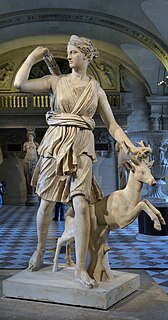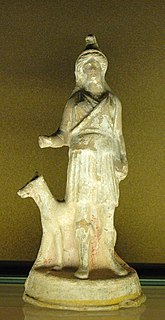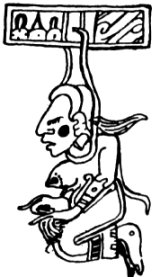 W
WA hunting deity is a god or goddess in mythology associated with the hunting of animals and the skills and equipment involved. They are a common feature of polytheistic religions.
 W
WAnat, Anatu, classically Anath is a major northwest Semitic goddess. Her attributes vary widely among different cultures and over time, and even within particular myths. She likely heavily influenced the character of the Greek goddess Athena.
 W
WArtemis is the Greek goddess of the hunt, the wilderness, wild animals, the Moon, and chastity. The goddess Diana is her Roman equivalent.
 W
WAstarte is the Hellenized form of the Ancient Near Eastern goddess Ashtart or Athtart, a deity closely related to Ishtar, worshipped from the Bronze Age through classical antiquity. The name is particularly associated with her worship in the ancient Levant among the Canaanites and Phoenicians, though she was originally associated with Amorite cities like Ugarit and Emar, as well as Mari and Ebla. She was also celebrated in Egypt following the importation of foreign cults there.
 W
WBendis was a Thracian goddess associated with hunting whom the Athenians identified with Artemis and who was introduced into Athens about 430 BC. She was a huntress, like Artemis, but was accompanied by dancing satyrs and maenads on a fifth-century red-figure stemless cup . Also known as Isis in Egypt and Diana in the Roman Empire, Bendis is believed to have originated in the Dacian Kingdom known today as Romania.
 W
WBritomartis was a Greek goddess of mountains and hunting, who was primarily worshipped on the island of Crete. She was sometimes believed to be an oread, or a mountain nymph, but she was often conflated or syncretized with Artemis and Aphaea, the "invisible" patroness of Aegina. She is also known as Diktynna.
 W
WDali is a goddess from the mythology of the Georgian people of the Caucasus region. She is a hunting goddess who serves as the patron of hoofed wild mountain animals such as ibexes and deer. Hunters who obeyed her numerous taboos would be assured of success in the hunt; conversely, she would harshly punish any who violated them. She is most prominently attested in the stories of the Svan ethnic subgroup in northwestern Georgia. Other groups in western Georgia had similar figures considered equivalent to Dali, such as the Mingrelian goddess Tkashi-Mapa.
 W
WDevana, Zevana, less often Zievonya is the goddess of wild nature, forests, hunting and the moon worshiped by the Western Slavs. In the sources, she was first mentioned in the 15th century by Jan Długosz, who compared her to the Roman goddess Diana. Dziewanna is also a Polish name for Verbascum, and the etymology of the word is unclear. After strong criticism from Aleksander Brückner, researchers rejected her authenticity, but nowadays it is accepted by an increasing number of researchers. Sometimes, in folk rituals, she performs together with Morana. After Christianization, she could be replaced by Our Lady of Thunder Candle.
 W
WDiana is a goddess in Roman and Hellenistic religion, primarily considered a patroness of the countryside, hunters, crossroads, and the Moon. She is equated with the Greek goddess Artemis, and absorbed much of Artemis' mythology early in Roman history, including a birth on the island of Delos to parents Jupiter and Latona, and a twin brother, Apollo, though she had an independent origin in Italy.
 W
WAt the time of the Spanish conquest of Yucatán (1527–1546), Ix Tab or Ixtab was the indigenous Maya goddess of suicide by hanging. Playing the role of a psychopomp, she would accompany such suicides to heaven.
 W
WMayari, who embodies beauty and strength, is the one-eyed lunar deity of Tagalog, Sambal and Pampangan mythology in the Philippines. She rules over the night and is the guardian over beauty, strength, war, revolution, equality and the moon.
 W
WNeith was an early ancient Egyptian deity. She was said to be the first and the prime creator, who created the universe and all it contains, and that she governs how it functions. She was the goddess of the cosmos, fate, wisdom, water, rivers, mothers, childbirth, hunting, weaving, and war.
 W
WSatet, Satit or Satjet, Satjit in Ancient Egyptian, Greek: Satis, also known by numerous related names, was an Upper Egyptian goddess who, along with Khnum and Anuket, formed part of the Elephantine Triad. A protective deity of Egypt's southern border with Nubia, she came to personify the former annual flooding of the Nile and to serve as a war, hunting, and fertility goddess.
 W
WSedna is the goddess of the sea and marine animals in Inuit mythology, also known as the Mother of the Sea or Mistress of the Sea. Sedna is also known as Arnakuagsak or Arnaqquassaaq (Greenland) and Sassuma Arnaa and Nerrivik or Nuliajuk. She is sometimes known by other names by different Inuit groups such as Arnapkapfaaluk of the Copper Inuit from the Coronation Gulf area and Takánakapsâluk or Takannaaluk (Igloolik). In Killiniq, Labrador, she was referred to as "Old-woman-who-lived-in-the-sea". The story of Sedna, which is a creation myth, describes how she came to rule over Adlivun, the Inuit underworld.
 W
WIn Norse mythology, Skaði is a jötunn and goddess associated with bowhunting, skiing, winter, and mountains. Skaði is attested in the Poetic Edda, compiled in the 13th century from earlier traditional sources; the Prose Edda and in Heimskringla, written in the 13th century by Snorri Sturluson, and in the works of skalds.
 W
WLa Xtabay is a Yucatec Maya myth about the female demon, Xtabay, a supernatural femme fatale who preys upon men in the Yucatán Peninsula. She is said to dwell in the forest to lure men to their deaths with her incomparable beauty. She is described as having beautiful, shining black hair that falls down to her ankles and wearing a white dress. One of the most accepted versions of the myth comes from the book, Diez Leyendas Mayas (1998), written by Jesus Azcorra Alejos.